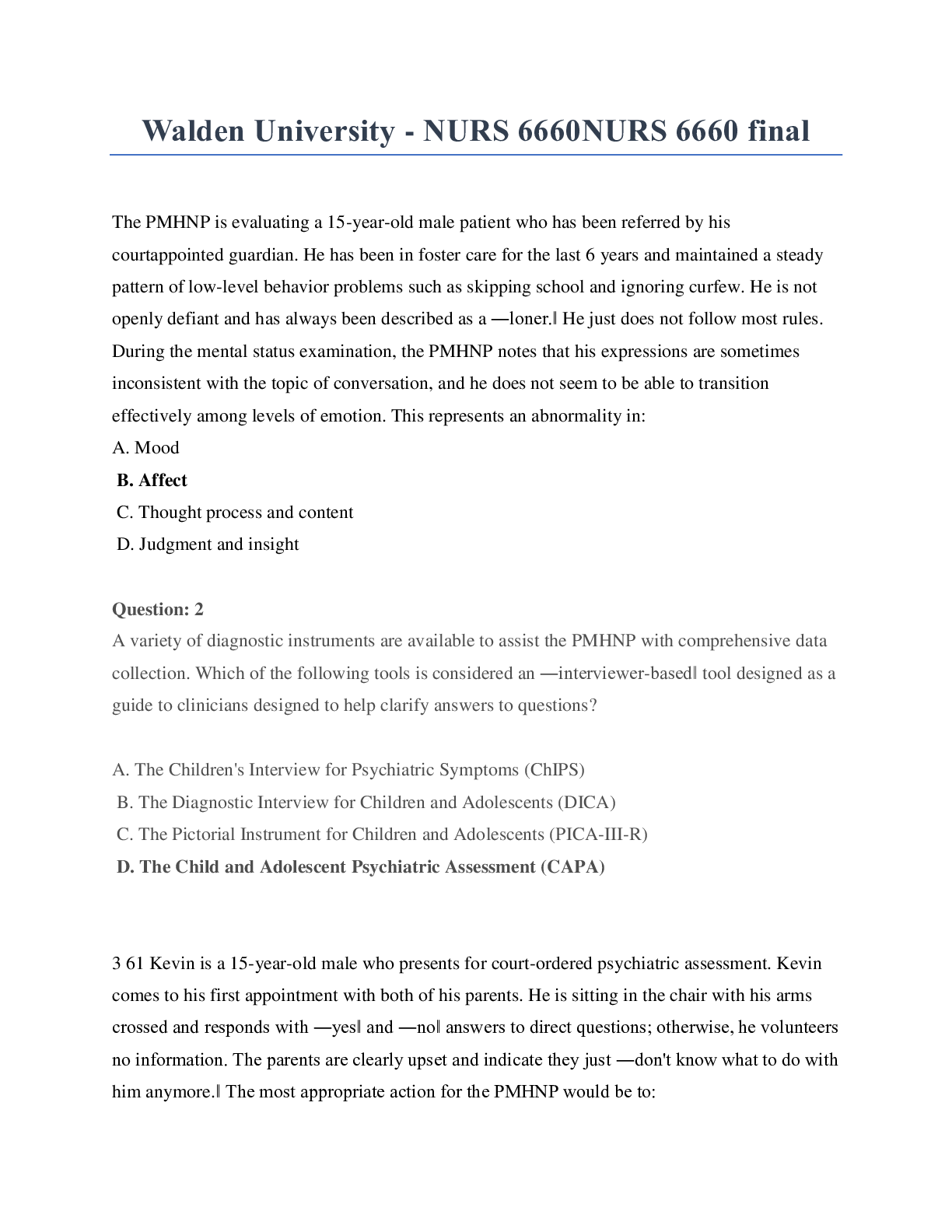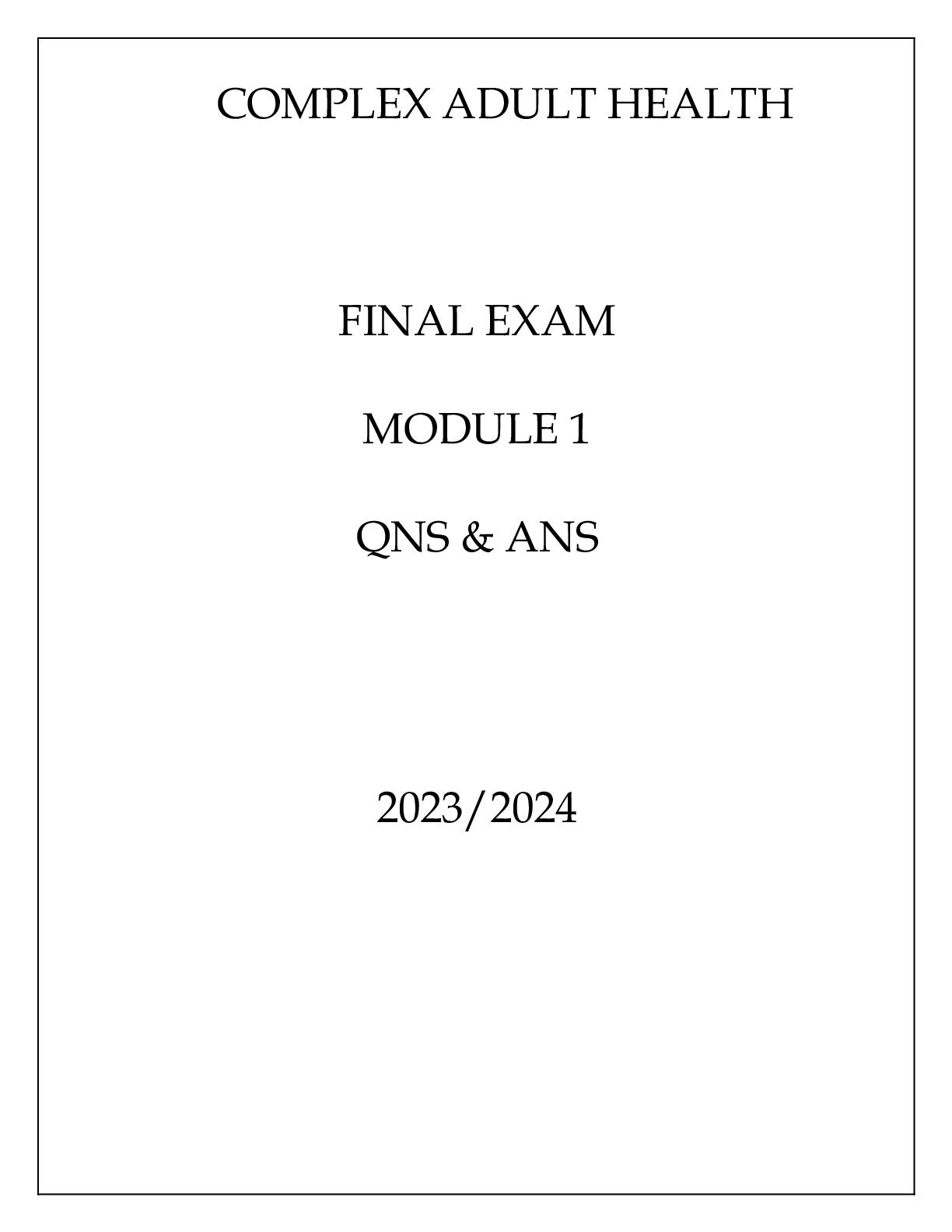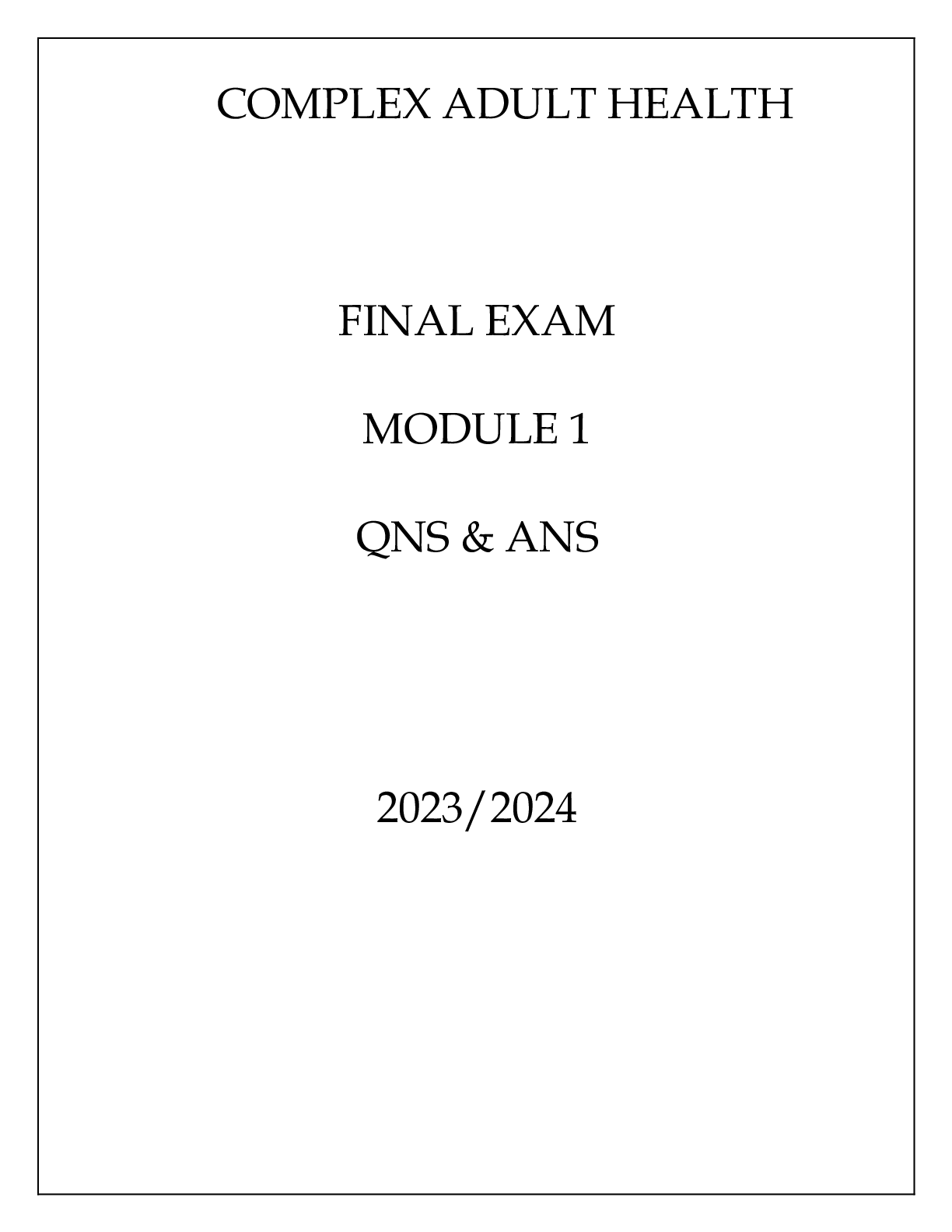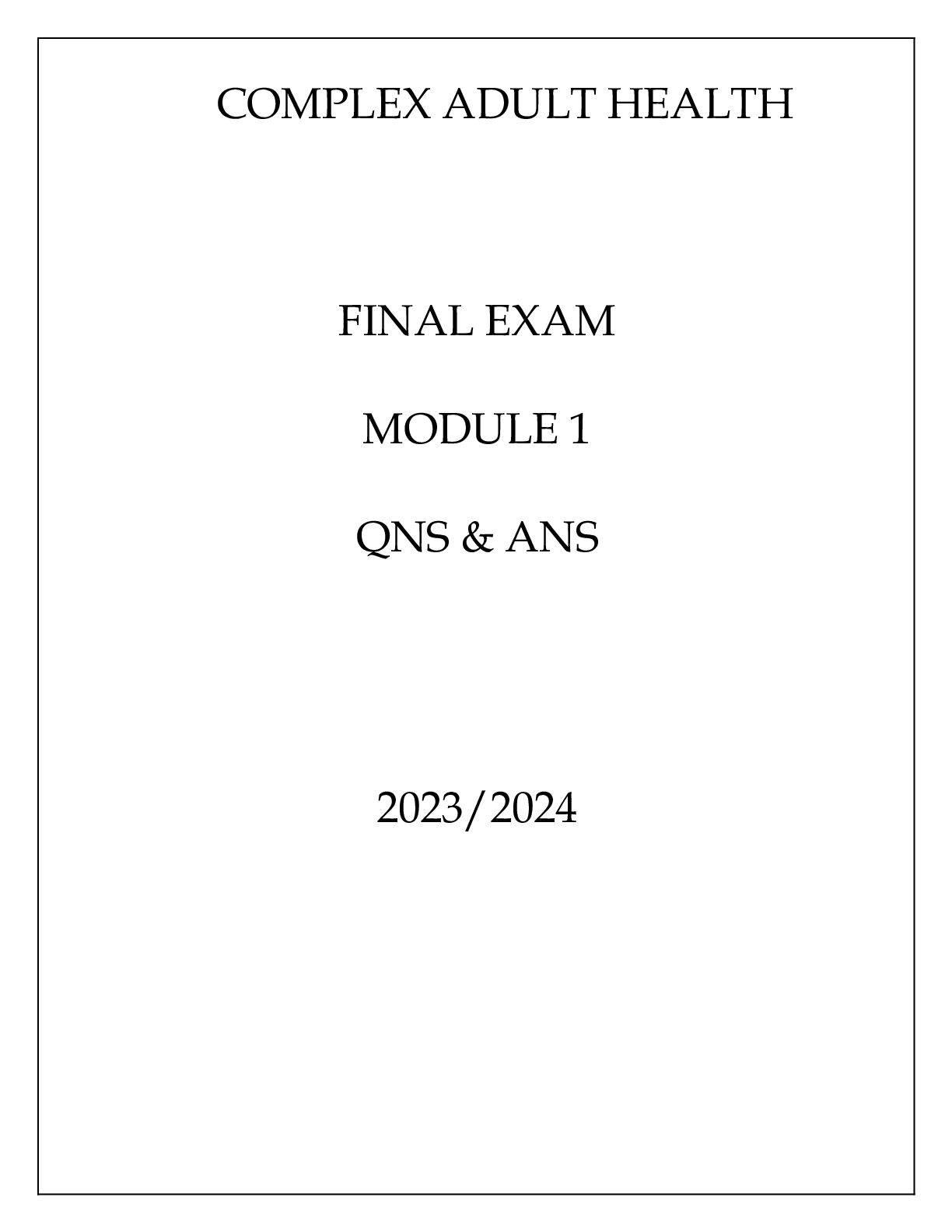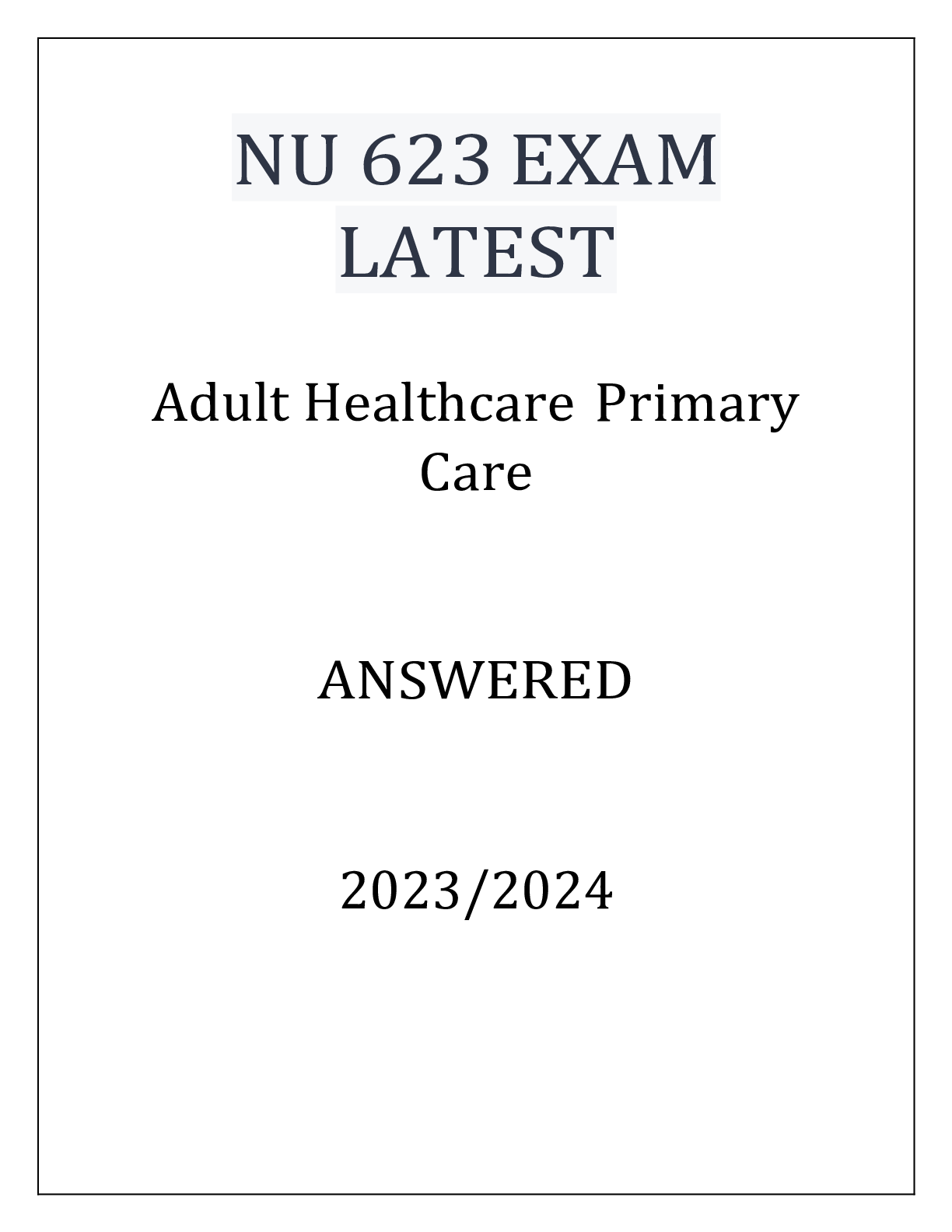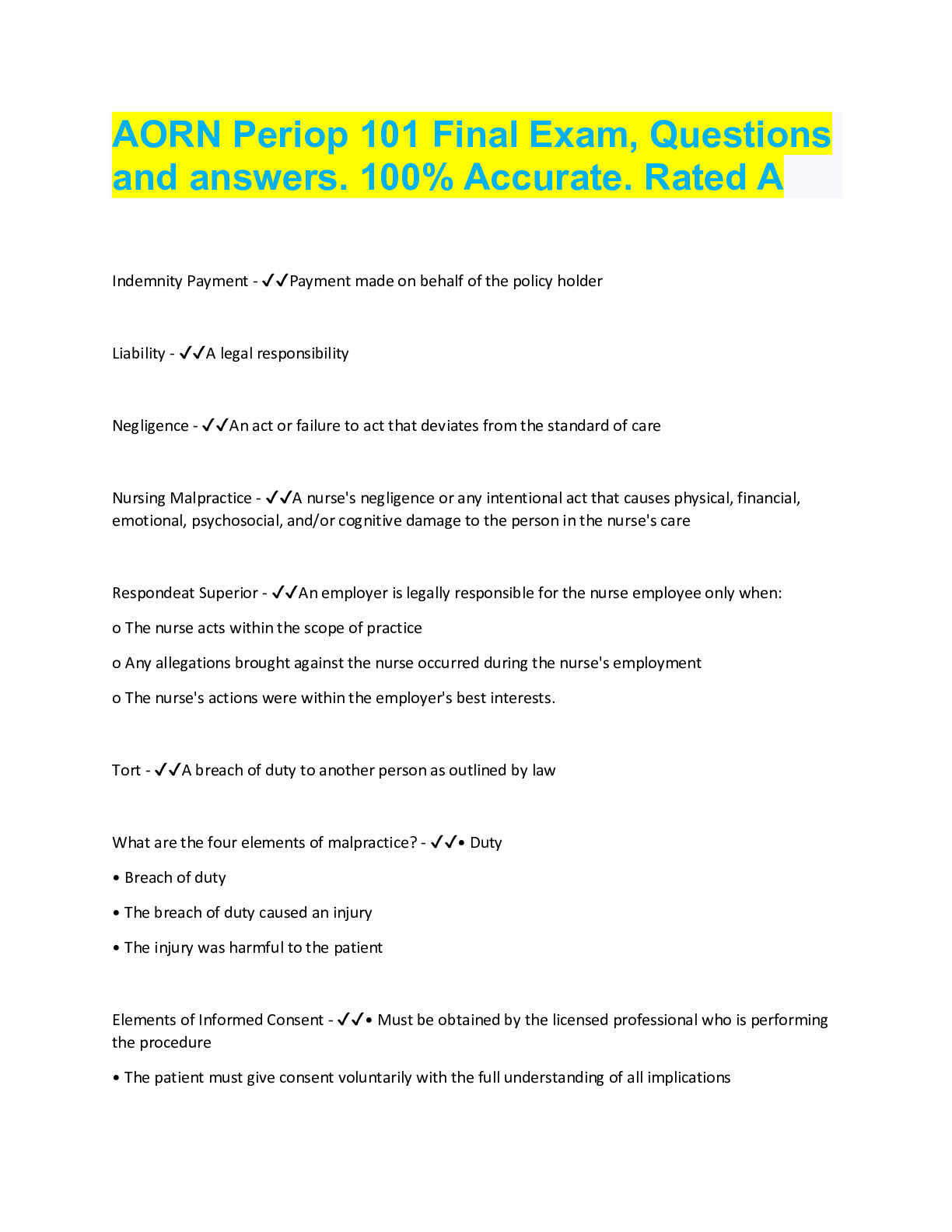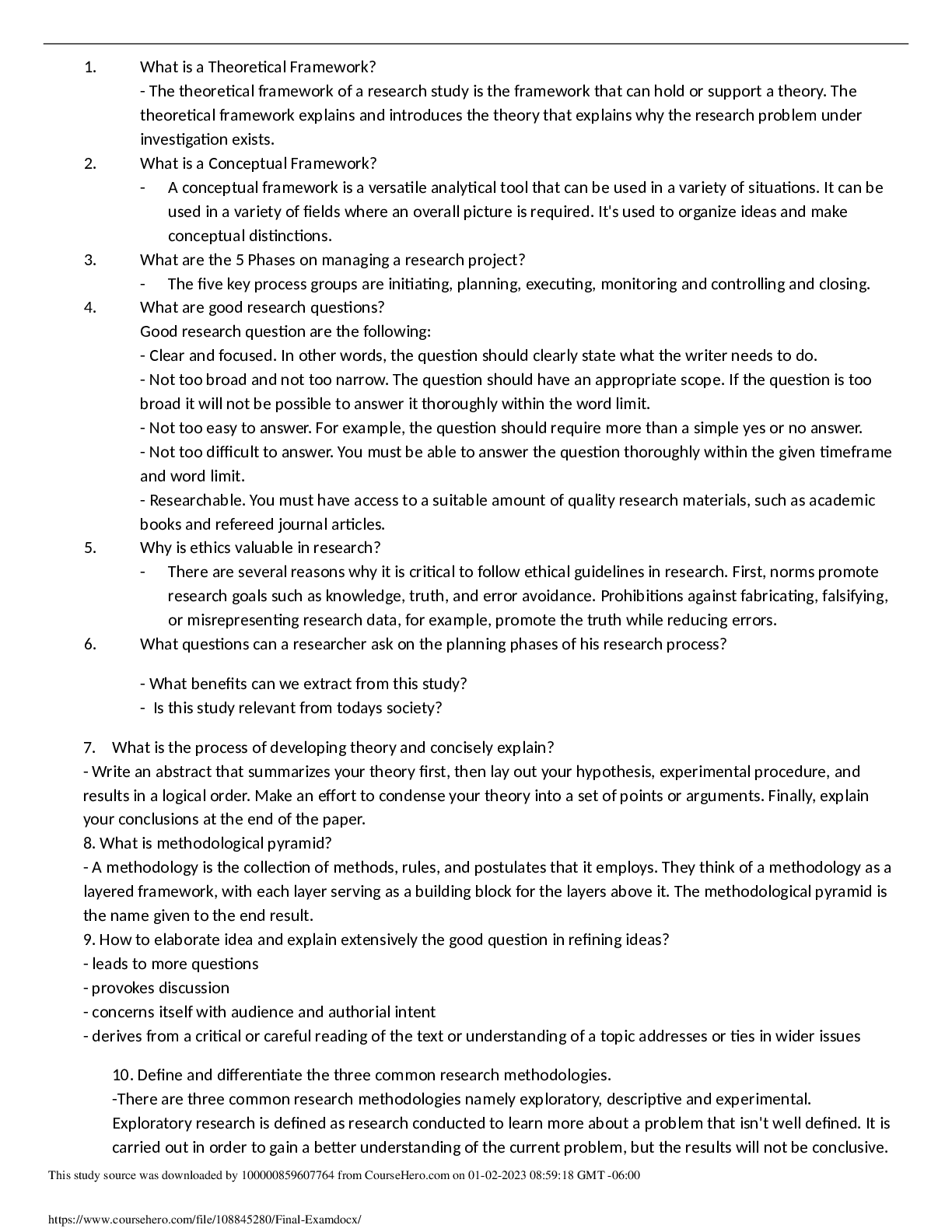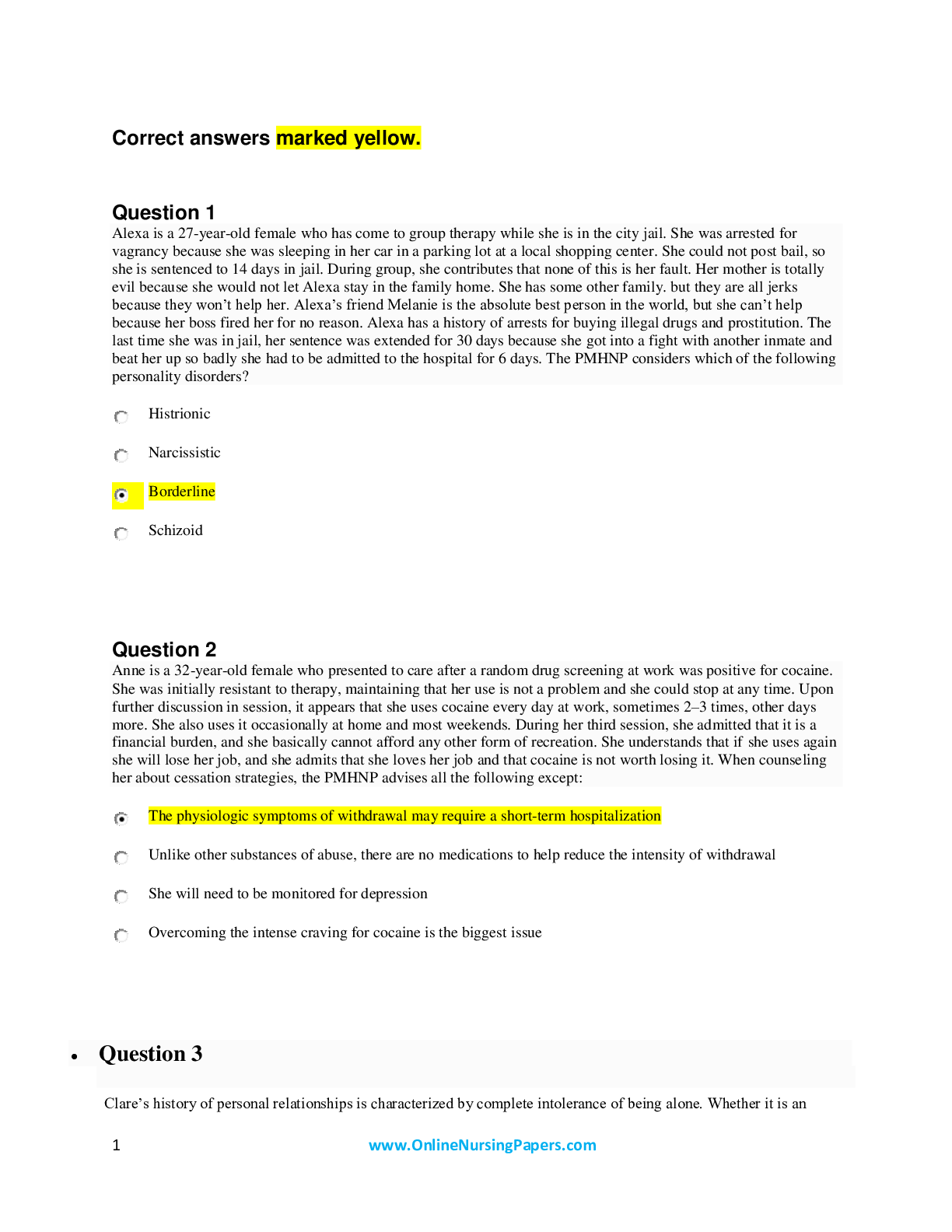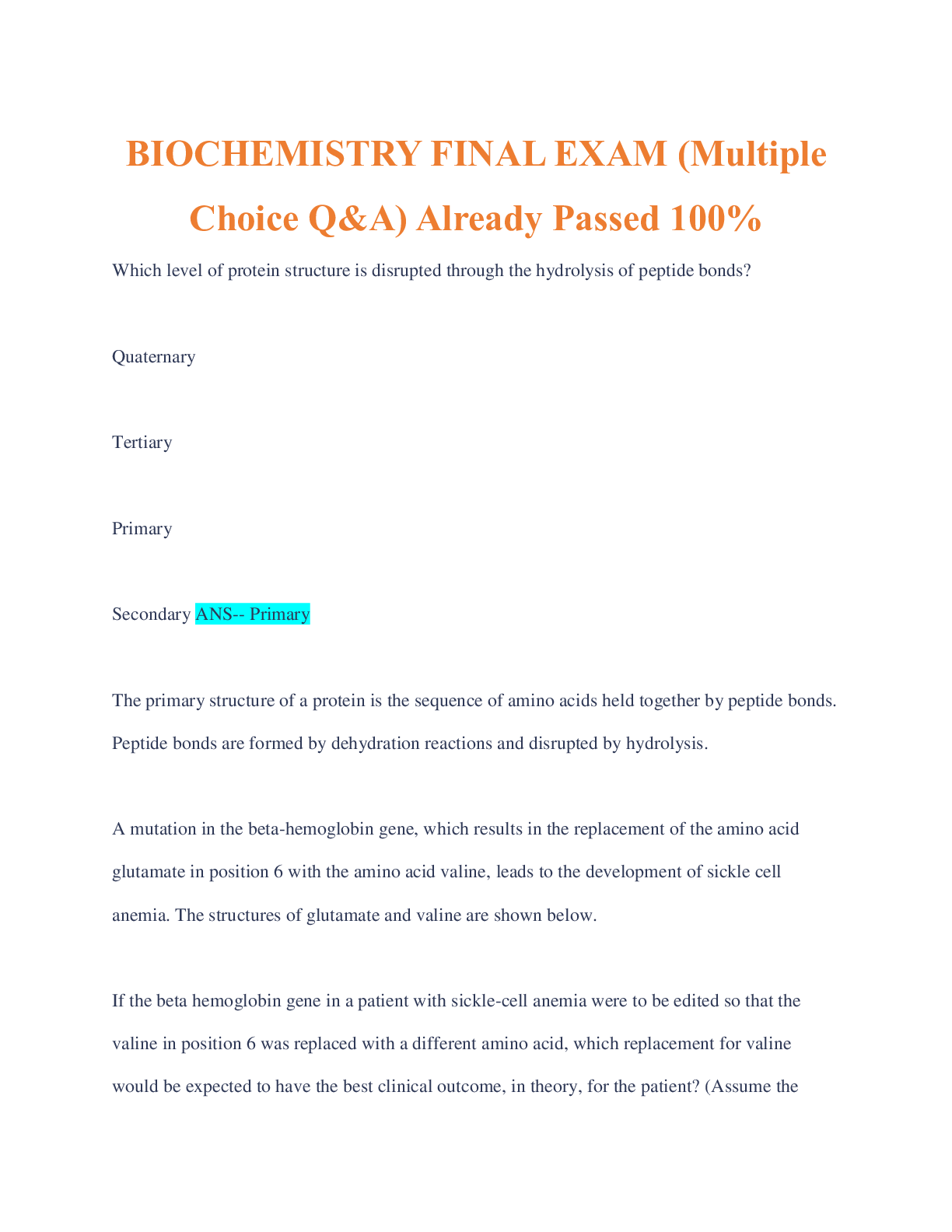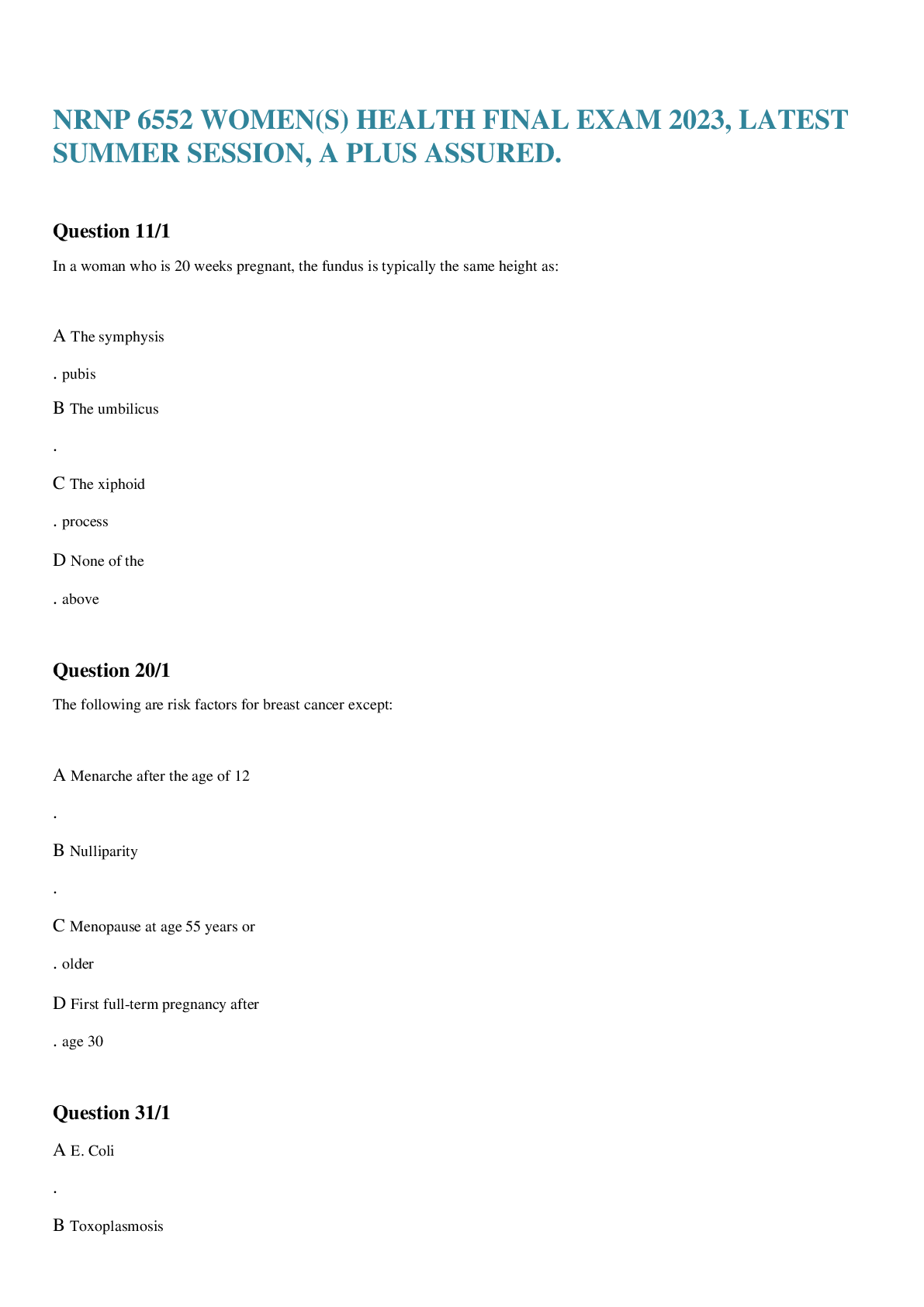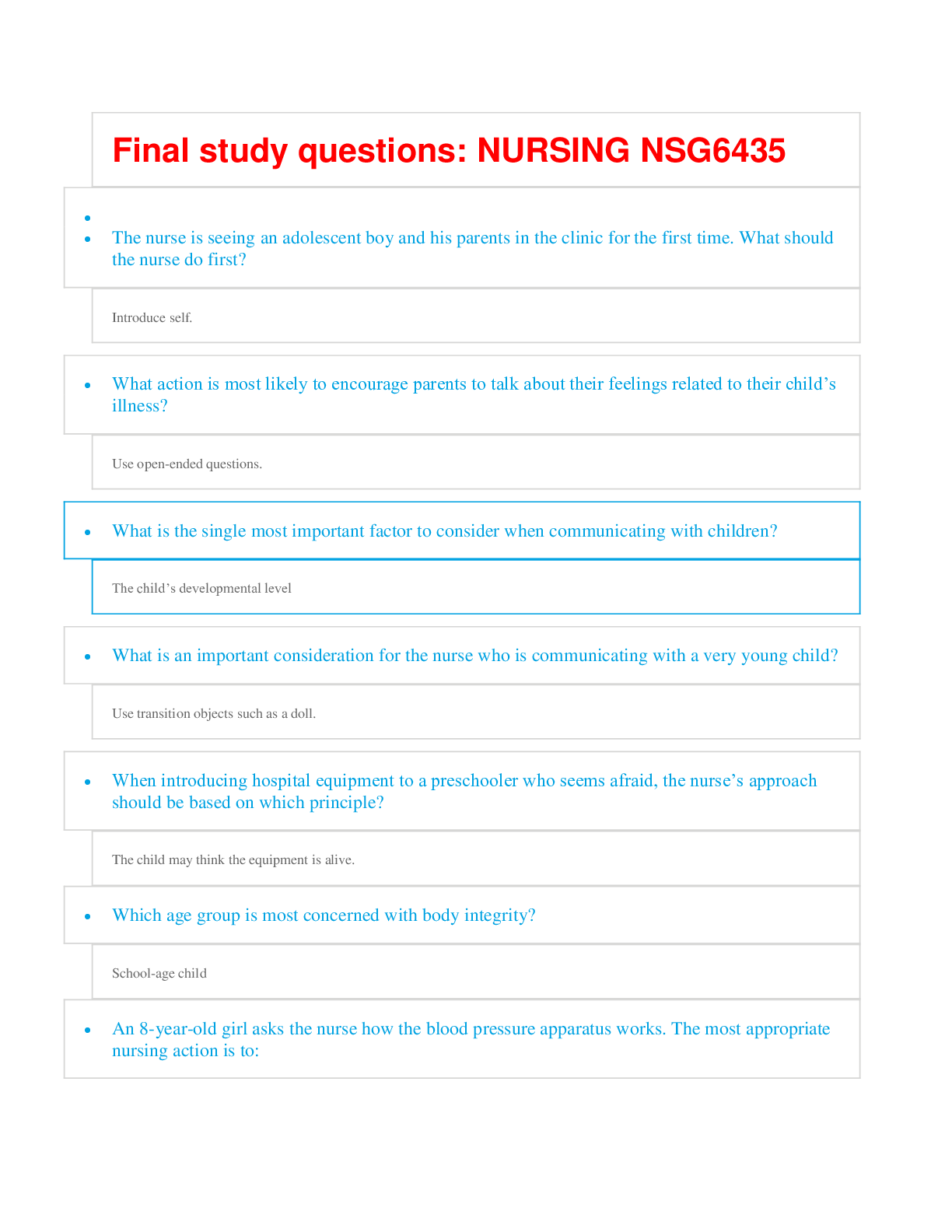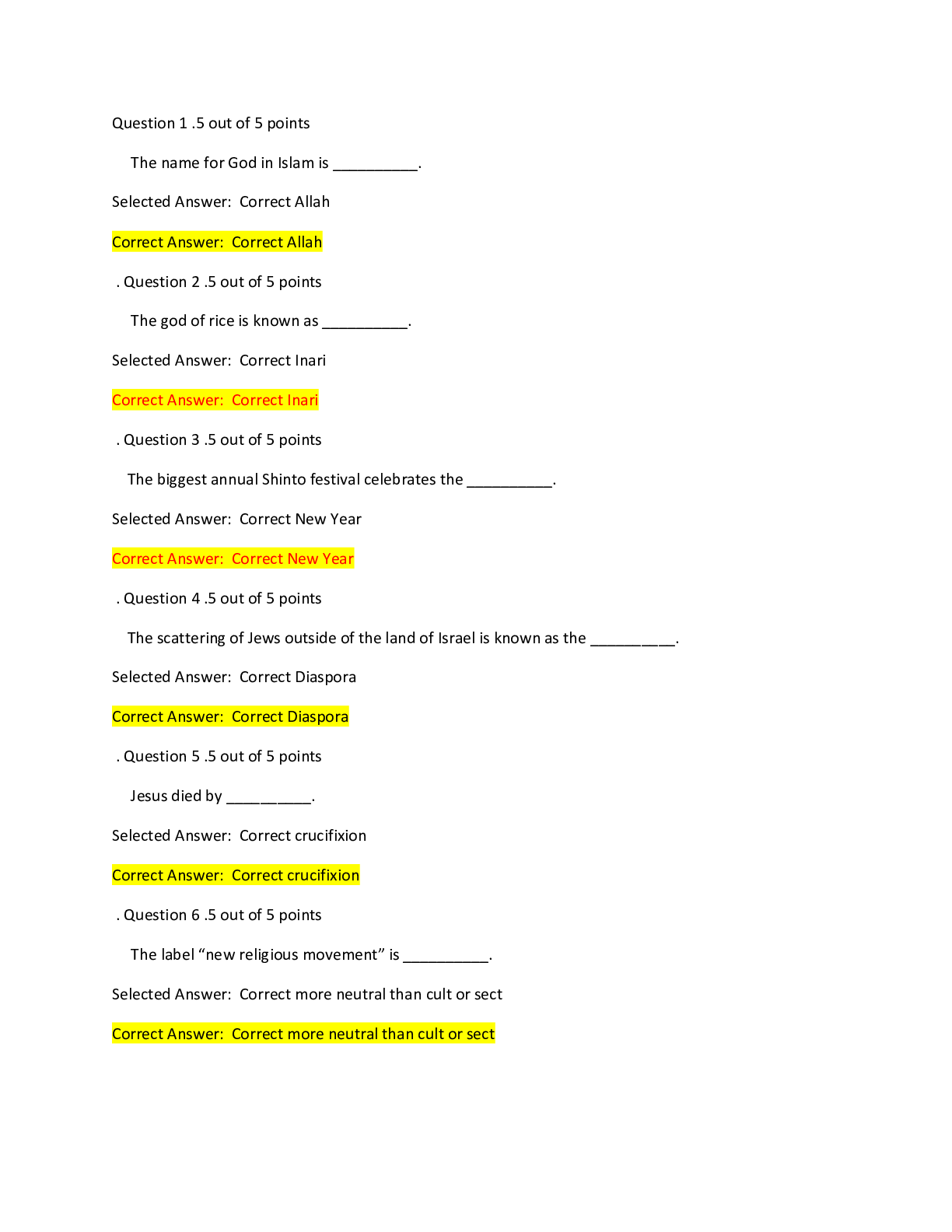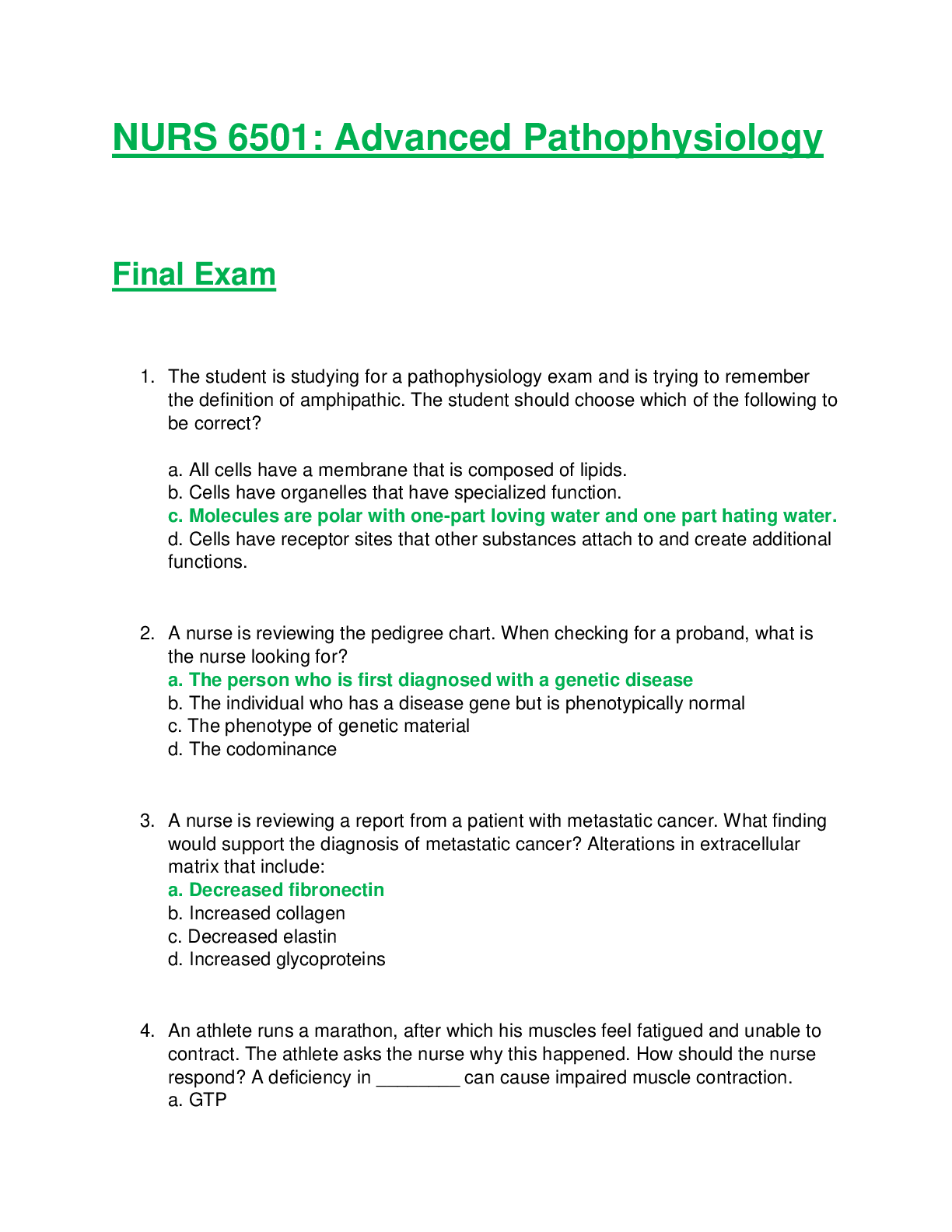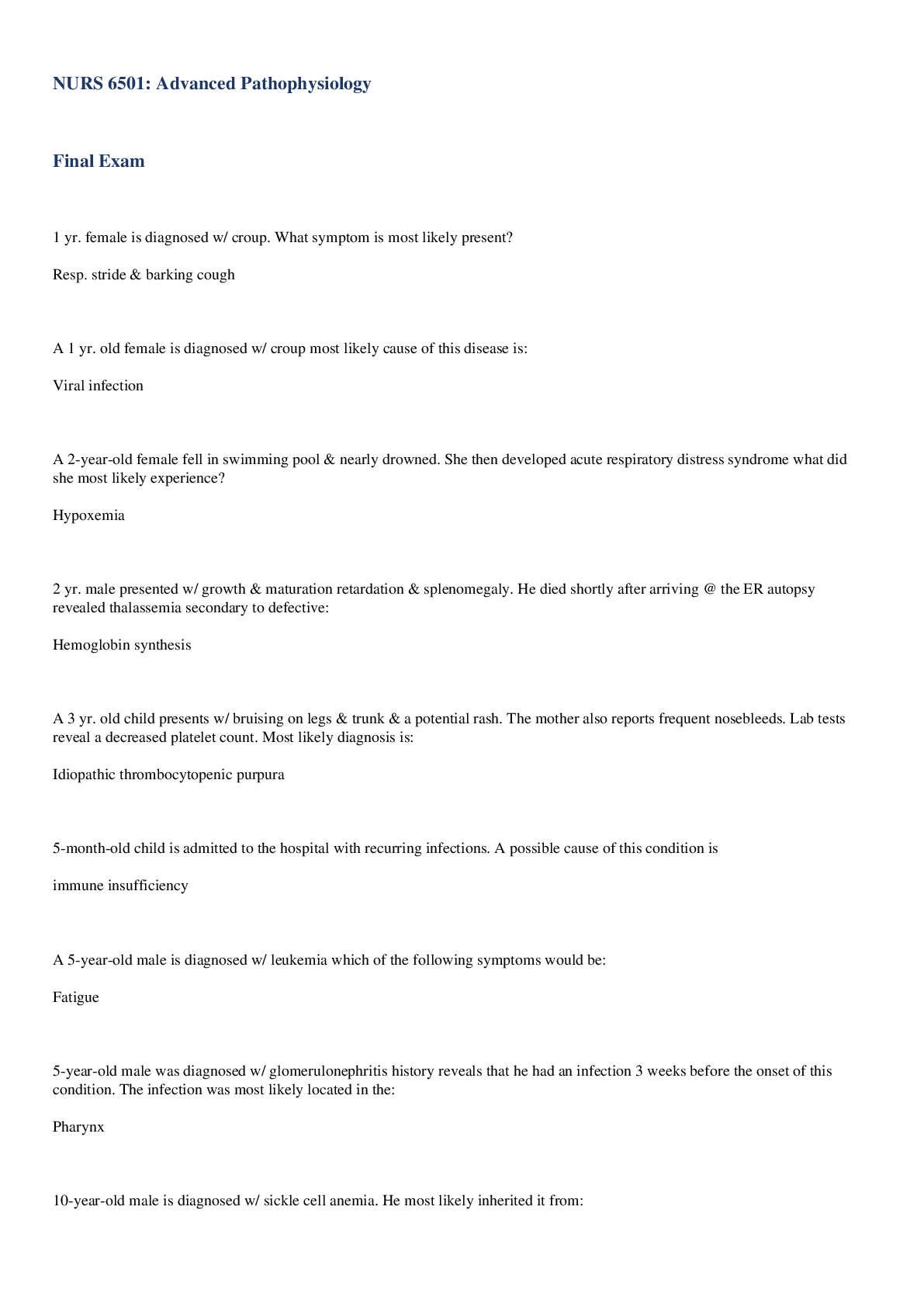*NURSING > FINAL EXAM > NU 216 Adult Health 1 - Herzing University_ FINAL EXAMS 1 & 2 Revised and Updated (All)
NU 216 Adult Health 1 - Herzing University_ FINAL EXAMS 1 & 2 Revised and Updated
Document Content and Description Below
NU 216 Adult Health 1 - Herzing University_ FINAL EXAMS 1 & 2 3. A patient is diagnosed with heart failure after being admitted to the hospital for shortness of breath and fatigue. Which teachin... g strategy, if implemented by the nurse, is most likely to be effective? a. Assure the patient that the nurse is an expert on management of heart failure. b. Teach the patient at each meal about the amounts of sodium in various foods. c. Discuss the importance of medication control in maintenance of long-term health. d. Refer the patient to a home health nurse for instructions on diet and fluid restrictions. 4. A patient who was admitted to the hospital with hyperglycemia and newly diagnosed diabetes mellitus is scheduled for discharge the second day after admission. When implementing patient teaching, what is the priority action for the nurse? a. Instruct about the increased risk for cardiovascular disease. b. Provide detailed information about dietary control of glucose. c. Teach glucose self-monitoring and medication administration. d. Give information about the effects of exercise on glucose control. 5. A patient states, “I told my husband I wouldn’t buy as much prepared food snacks, so I will go the grocery store to buy fresh fruit, vegetables, and whole grains.” When using the Transtheoretical Model of Health Behavior Change, the nurse identifies that this patient is in which stage of change? a. Preparation b. Termination c. Maintenance d. Contemplation A 6. While admitting a patient to the medical unit, the nurse determines that the patient is hard of hearing. How should the nurse use this information to plan teaching and learning strategies? a. Motivation and readiness to learn will be affected. b. The family must be included in the teaching process. c. The patient will have problems understanding information. d. Written materials should be provided with verbal instructions. 7. A patient who is morbidly obese states, “I’ve recently made some changes in my life. I’ve decreased my fat intake and I’ve stopped smoking.” Which statement, if made by the nurse, is the best initial response? a. “Although those are important, it is essential that you make other changes, too.” b. “Are you having any difficulty in maintaining the changes you have already made?” c. “Which additional changes in your lifestyle would you like to implement at this time?” d. “You have already accomplished changes that are important for the health of your heart.” 8. The nurse is planning a teaching session with a patient newly diagnosed with migraine headaches. To assess a patient’s readiness to learn, which question should the nurse ask? a. “What kind of work and leisure activities do you do?” b. “What information do you think you need right now?” c. “Can you describe the types of activities that help you learn new information?” d. “Do you have any religious beliefs that are inconsistent with the planned treatment?” 10. A patient with diabetic neuropathy requires teaching about foot care. Which learning goal should the nurse include in the teaching plan? a. The nurse will demonstrate the proper technique for trimming toenails. b. The patient will list three ways to protect the feet from injury by discharge. c. The nurse will instruct the patient on appropriate foot care before discharge. d. The patient will understand the rationale for proper foot care after instruction. 12. The nurse and the patient who is diagnosed with hypertension develop this goal: “The patient will select a 2-gram sodium diet from the hospital menu for the next 3 days.” Which evaluation method will be best for the nurse to use when determining whether teaching was effective? a. Have the patient list substitutes for favorite foods that are high in sodium. b. Check the sodium content of the patient’s menu choices over the next 3 days. c. Ask the patient to identify which foods on the hospital menus are high in sodium. d. Compare the patient’s sodium intake before and after the teaching was implemented. 14. The hospital nurse implements a teaching plan to assist an older patient who lives alone to independently accomplish daily activities. How would the nurse best evaluate the patient’s long-term response to the teaching? a. Make a referral to the home health nursing department for home visits. b. Have the patient demonstrate the learned skills at the end of the teaching session. c. Arrange a physical therapy visit before the patient is discharged from the hospital. d. Check the patient’s ability to bathe and get dressed without any assistance the next day. 15. A patient who smokes a pack of cigarettes per day tells the nurse, “I enjoy smoking and have no plans to quit.” Which nursing diagnosis is mostappropriate? a. Health seeking behaviors related to cigarette use b. Ineffective health maintenance related to tobacco use c. Readiness for enhanced self-health management related to smoking d. Deficient knowledge related to long-term effects of cigarette smoking 18. The nurse plans to teach a patient and the caregiver how to manage high blood pressure (BP). Which action should the nurse take first? a. Give written information about hypertension to the patient and caregiver. b. Have the dietitian meet with the patient and caregiver to discuss a low sodium diet. c. Teach the caregiver how to take the patient’s BP using a manual blood pressure cuff. d. Ask the patient and caregiver to select information from a list of high BP teaching topics. 1. The nurse plans to provide instructions about diabetes to a patient who has a low literacy level. Which teaching strategies should the nurse use (select all that apply)? a. Discourage use of the Internet as a source of health information. b. Avoid asking the patient about reading abilities and level of education. c. Provide illustrations and photographs showing various types of insulin. d. Schedule one-to-one teaching sessions to practice insulin administration. e. Obtain CDs and DVDs that illustrate how to perform blood glucose testing. Chapter 5: Chronic Illness and Older Adults 1. When caring for an older patient with hypertension who has been hospitalized after a transient ischemic (TIA), which topic is the most important for the nurse to include in the discharge teaching? a. Effect of atherosclerosis on blood vessels b. Mechanism of action of anticoagulant drug therapy c. Symptoms indicating that the patient should contact the health care provider d. Impact of the patient’s family history on likelihood of developing a serious stroke 2. The nurse performs a comprehensive geriatric assessment of a patient who is being assessed for admission to an assisted living facility. Which question is the most important for the nurse to ask? a. “Have you had any recent infections?” b. “How frequently do you see a doctor?” c. “Do you have a history of heart disease?” d. “Are you able to prepare your own meals?” 5. An older patient is hospitalized with pneumonia. Which intervention should the nurse implement to provide optimal care for this patient? a. Use a standardized geriatric nursing care plan. b. Minimize activity level during hospitalization. c. Plan for transfer to a long-term care facility upon discharge. d. Consider the preadmission functional abilities when setting patient goals. 6. The nurse cares for an older adult patient who lives in a rural area. Which intervention should the nurse plan to implement to best meet this patient’s needs? a. Suggest that the patient move to an urban area. b. Assess the patient for chronic diseases that are unique to rural areas. c. Ensure transportation to appointments with the health care provider. d. Obtain adequate medications for the patient to last for 4 to 6 months. 7. Which nursing action will be most helpful in decreasing the risk for drug-drug interactions in an older adult? a. Teach the patient to have all prescriptions filled at the same pharmacy. b. Instruct the patient to avoid taking over-the-counter (OTC) medications. c. Make a schedule for the patient as a reminder of when to take each medication. d. Have the patient bring all medications, supplements, and herbs to each appointment. 10. The nurse admits an acutely ill, older patient to the hospital. Which action should the nurse take first? a. Speak slowly and loudly while facing the patient. b. Obtain a detailed medical history from the patient. c. Perform the physical assessment before interviewing the patient. d. Ask a family member to go home and retrieve the patient’s cane. 11. The nurse cares for an alert, homeless older adult patient who was admitted to the hospital with a chronic foot infection. Which intervention is themost appropriate for the nurse to include in the discharge plan for this patient? a. Refer the patient to social services for further assessment. b. Teach the patient how to assess and care for the foot infection. c. Schedule the patient to return to outpatient services for foot care. d. Give the patient written information about shelters and meal sites. 14. Which statement, if made by an older adult patient, would be of most concern to the nurse? a. “I prefer to manage my life without much help from other people.” b. “I take three different medications for my heart and joint problems.” c. “I don’t go on daily walks anymore since I had pneumonia 3 months ago.” d. “I set up my medications in a marked pillbox so I don’t forget to take them.” 19. The family of an older patient with chronic health problems and increasing weakness is considering placement in a long-term care (LTC) facility. Which action by the nurse will be most helpful in assisting the patient to make this transition? a. Have the family select a LTC facility that is relatively new. b. Obtain the patient’s input about the choice of a LTC facility. c. Ask that the patient be placed in a private room at the facility. d. Explain the reasons for the need to live in LTC to the patient. 20. The nurse manages the care of older adults in an adult health day care center. Which action can the nurse delegate to unlicensed assistive personnel (UAP)? a. Obtain information about food and medication allergies from patients. b. Take blood pressures daily and document in individual patient records. c. Choose social activities based on the individual patient needs and desires. d. Teach family members how to cope with patients who are cognitively impaired. MULTIPLE RESPONSE 1. Which nursing actions will the nurse take to assess for possible malnutrition in an older adult patient (select all that apply)? a. Observe for depression. b. Review laboratory results. c. Assess teeth and oral mucosa. d. Ask about transportation needs. e. Determine food likes and dislikes. 1. The nurse assesses a patient’s surgical wound on the first postoperative day and notes redness and warmth around the incision. Which action by the nurse is most appropriate? a. Obtain wound cultures. b. Document the assessment. c. Notify the health care provider. d. Assess the wound every 2 hours. 6. A patient has an open surgical wound on the abdomen that contains deep pink granulation tissue. How would the nurse document this wound? a. Red wound b. Yellow wound c. Full-thickness wound d. Stage III pressure ulcer 7. A patient with rheumatoid arthritis has been taking corticosteroids for 11 months. Which nursing action is most likely to detect early signs of infection in this patient? a. Monitor white blood cell count. b. Check the skin for areas of redness. c. Check the temperature every 2 hours. d. Ask about fatigue or feelings of malaise. 9. A patient from a long-term care facility is admitted to the hospital with a sacral pressure ulcer. The base of the wound is yellow and involves subcutaneous tissue. How should the nurse classify this pressure ulcer? a. Stage I b. Stage II c. Stage III d. Stage IV 10. A young male patient who is a paraplegic has a stage II sacral pressure ulcer and is being cared for at home by his mother. To prevent further tissue damage, what instructions are most important for the nurse to teach the mother? a. Change the patient’s bedding frequently. b. Use a hydrocolloid dressing over the ulcer. c. Record the size and appearance of the ulcer weekly. d. Change the patient’s position at least every 2 hours. 11. The nurse will perform which action when doing a wet-to-dry dressing change on a patient’s stage III sacral pressure ulcer? a. Soak the old dressings with sterile saline 30 minutes before removing them. b. Pour sterile saline onto the new dry dressings after the wound has been packed. c. Apply antimicrobial ointment before repacking the wound with moist dressings. d. Administer the ordered PRN hydrocodone (Lortab) 30 minutes before the dressing change. 18. A patient who has diabetes is admitted for an exploratory laparotomy for abdominal pain. When planning interventions to promote wound healing, what is the nurse’s highest priority? a. Maintaining the patient’s blood glucose within a normal range b. Ensuring that the patient has an adequate dietary protein intake c. Giving antipyretics to keep the temperature less than 102° F (38.9° C) d. Redressing the surgical incision with a dry, sterile dressing twice daily 20. After the home health nurse teaches a patient’s family member about how to care for a sacral pressure ulcer, which finding indicates that additional teaching is needed? a. The family member uses a lift sheet to reposition the patient. b. The family member uses clean tap water to clean the wound. c. The family member places contaminated dressings in a plastic grocery bag. d. The family member dries the wound using a hair dryer set on a low setting. SHORT ANSWER 1. A patient’s temperature has been 101° F (38.3° C) for several days. The patient’s normal caloric intake to meet nutritional needs is 2000 calories per day. Knowing that the metabolic rate increases 7% for each Fahrenheit degree above 100° in body temperature, how many total calories should the patient receive each day? OTHER 1. A patient who has an infected abdominal wound develops a temperature of 104° F (40° C). All the following interventions are included in the patient’s plan of care. In which order should the nurse perform the following actions?(Put a comma and a space between each answer choice [A, B, C, D]). a. Administer IV antibiotics. b. Sponge patient with cool water. c. Perform wet-to-dry dressing change. d. Administer acetaminophen (Tylenol). 2. A new mother expresses concern about her baby developing allergies and asks what the health care provider meant by “passive immunity.” Which example should the nurse use to explain this type of immunity? a. Early immunization b. Bone marrow donation c. Breastfeeding her infant d. Exposure to communicable diseases 3. A patient is being evaluated for possible atopic dermatitis. The nurse expects elevation of which laboratory value? a. IgE b. IgA c. Basophils d. Neutrophils 6. Which teaching should the nurse provide about intradermal skin testing to a patient with possible allergies? a. “Do not eat anything for about 6 hours before the testing.” b. “Take an oral antihistamine about an hour before the testing.” c. “Plan to wait in the clinic for 20 to 30 minutes after the testing.” d. “Reaction to the testing will take about 48 to 72 hours to occur.” 12. Which patient should the nurse assess first? a. Patient with urticaria after receiving an IV antibiotic b. Patient who has graft-versus-host disease and severe diarrhea c. Patient who is sneezing after having subcutaneous immunotherapy d. Patient with multiple chemical sensitivities who has muscle stiffness 13. Ten days after receiving a bone marrow transplant, a patient develops a skin rash. What would the nurse suspect is the cause of this patient’s skin rash? a. The donor T cells are attacking the patient’s skin cells. b. The patient’s antibodies are rejecting the donor bone marrow. c. The patient is experiencing a delayed hypersensitivity reaction. d. The patient will need treatment to prevent hyperacute rejection. 15. The nurse teaches a patient about drug therapy after a kidney transplant. Which statement by the patient would indicate a need for further instructions? a. “After a couple of years, it is likely that I will be able to stop taking the cyclosporine.” b. “If I develop an acute rejection episode, I will need to have other types of drugs given IV.” c. “I need to be monitored closely because I have a greater chance of developing malignant tumors.” d. “The drugs are given in combination because they inhibit different ways the kidney can be rejected.” 18. The charge nurse is assigning rooms for new admissions. Which patient would be the most appropriate roommate for a patient who has acute rejection of an organ transplant? a. A patient who has viral pneumonia b. A patient with second-degree burns c. A patient who is recovering from an anaphylactic reaction to a bee sting d. A patient with graft-versus-host disease after a recent bone marrow transplant 19. A patient who has received allergen testing using the cutaneous scratch method has developed itching and swelling at the skin site. Which action should the nurse take first? a. Administer epinephrine. b. Apply topical hydrocortisone. c. Monitor the patient for lower extremity edema. d. Ask the patient about exposure to any new lotions or soaps. 20. A patient who is anxious and has difficulty breathing seeks treatment after being stung by a wasp. What is the nurse’s priority action? a. Have the patient lie down. b. Assess the patient’s airway. c. Administer high-flow oxygen. d. Remove the stinger from the site. 23. The health care provider asks the nurse whether a patient’s angioedema has responded to prescribed therapies. Which assessment should the nurse perform? a. Ask the patient about any clear nasal discharge. b. Obtain the patient’s blood pressure and heart rate. c. Check for swelling of the patient’s lips and tongue. d. Assess the patient’s extremities for wheal and flare lesions. 24. A nurse has obtained donor tissue typing information about a patient who is waiting for a kidney transplant. Which results should be reported to the transplant surgeon? a. Patient is Rh positive and donor is Rh negative b. Six antigen matches are present in HLA typing c. Results of patient-donor cross matching are positive d. Panel of reactive antibodies (PRA) percentage is low 1. A patient who is receiving an IV antibiotic develops wheezes and dyspnea. In which order should the nurse implement these prescribed actions?(Put a comma and a space between each answer choice [A, B, C, D, E]). a. Discontinue the antibiotic infusion. b. Give diphenhydramine (Benadryl) IV. c. Inject epinephrine (Adrenalin) IM or IV. d. Prepare an infusion of dopamine (Intropin). e. Start 100% oxygen using a nonrebreather mask. 1. The nurse is caring for a patient with a massive burn injury and possible hypovolemia. Which assessment data will be of most concern to the nurse? a. Blood pressure is 90/40 mm Hg. b. Urine output is 30 mL over the last hour. c. Oral fluid intake is 100 mL for the last 8 hours. d. There is prolonged skin tenting over the sternum. 3. A patient is admitted for hypovolemia associated with multiple draining wounds. Which assessment would be the most accurate way for the nurse to evaluate fluid balance? a. Skin turgor b. Daily weight c. Presence of edema d. Hourly urine output 4. The home health nurse cares for an alert and oriented older adult patient with a history of dehydration. Which instructions should the nurse give to this patient related to fluid intake? a. “Increase fluids if your mouth feels dry. b. “More fluids are needed if you feel thirsty.” c. “Drink more fluids in the late evening hours.” d. “If you feel lethargic or confused, you need more to drink.” [Show More]
Last updated: 9 months ago
Preview 1 out of 39 pages
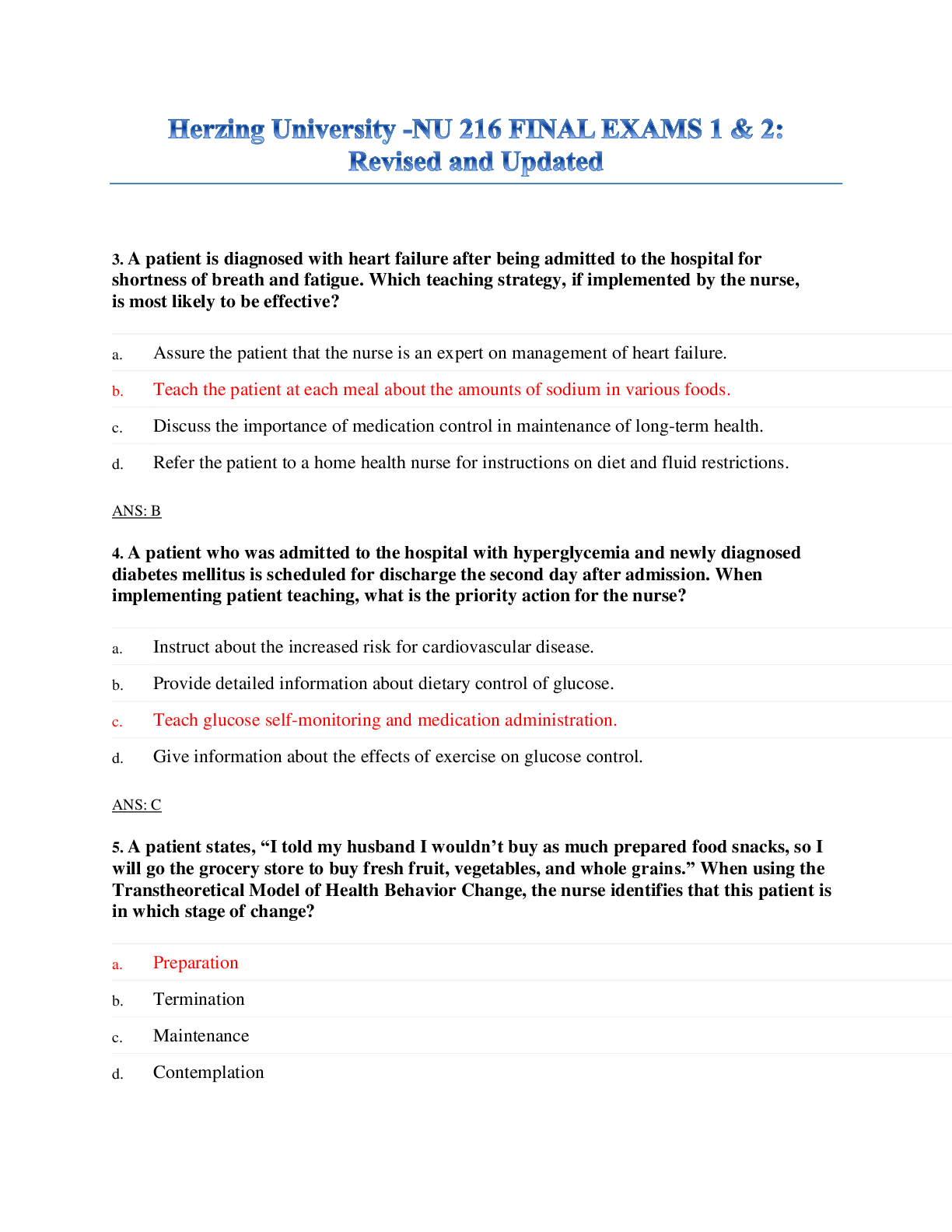
Reviews( 0 )
Document information
Connected school, study & course
About the document
Uploaded On
Mar 19, 2020
Number of pages
39
Written in
Additional information
This document has been written for:
Uploaded
Mar 19, 2020
Downloads
2
Views
214

